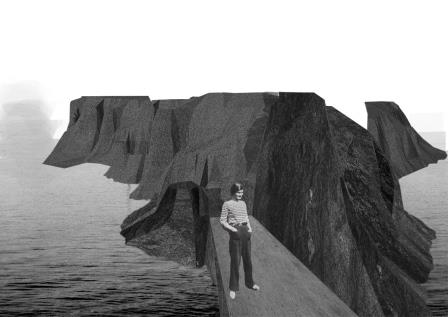Diploma 2015: "Nothing is Forever / Everything Is" by Marianne Lucie Skuncke
The Landing on the Skogsøya island, is the result of a personal travel and investigation - a project that ended up way off from where it started. The initial focus was to document and investigate contemporary ruins i Northern Norway with specific focus on how the fishing industry has changed drastically the past 60 years, leaving behind structures in decay along the (Northern) Norwegian coastline. My travels started in Vesterålen, where the island of Skogsøya, and the abandonned fishery Sørsand, soon became the main focus. Sørsand was once a significant fishery in Vesterålen, strategically placed on the northwest side of the island, towards the Atlantic, close to the fish banks and with substantial amount of farm land. After it was abandoned in 1956, the place was left to decay. Today remains only the foundation walls of the houses and the harbour and imprints of the once farmed fieldscapes.
Ever moving / Ever changing. When does a place cease to exist? Can the structures that have been in the landscape for a long time, be read as a part of the landscape itself, as they are no longer cut off from the landscape, but start belonging to it? The processes that act upon the landscape, are not only those of human forces. Natural processes such as geologic (trans)formations have been ongoing for millions of years, and still are. Time leaves it’s mark on all parts of the landscape. Nothing is constant. The landscape is always in movement and constantly being moved.
My initial feeling arriving on the island had been some sort of nostalgia or sadness for the loss of a place. All these imprints of recently lived life touched me deeply. What revealed itself as an opening to the working proces was adressing all time spans and life cycles in the landscape, not only those of human interventions.
Redefinition of a site through architectural interventions
The aim of the project is to address the relationship between place, architecture and the forces of time. Exploring architectural design as a way to relate the interrelated concepts of place and time to a human scale. I have attempted to investigate how architectural interventions can make us reflect on our perception of-, and way of relating to place. The final design both has a functional program – access to the island – as well as an aesthetic program underscoring the relationship between natural forces and human interventions as forces that act upon the landscape.
Taking measures / Designing. The Landing facilitates an access to Sørsand, as a harbour does no longer exist. The design is also an instrument for measurement, measuring the tide, and giving access to land when the tide is low, revealing the forces of gravity, the moon in relation to the earth, and how they move this specific place. Everything connected and mutually effected.
By creating a connection and disconnection to the island, there will be an endless ongoing discussion of whether the landing is becoming a part of Sørsand as a place, restoring its status as a place, or becoming a place of its own. The Landing can be seen as juxtaposed with the existing man made structures, that clearly show a linear life span, now merging into the landscape and becoming part of it. The Landing both measures the cyclic time, the tide, the gravity, but also linear time, as it will someday disappear and become a layer to the existing landscape. And by this it becomes a victim to Russells paradox; the list that contains itself.
The placement between sea and land makes it a constant renewal of a bridge, a constant renewal of a gap. A connection and disconnection between endless and solid. Between sea and land.
.jpg) Manmade imprints onto the landscape. Ruin 14.
Manmade imprints onto the landscape. Ruin 14.

The last ice age lasted 100 000 years. After the ice melted, the land rose 15 metres.

Situation. Directions.

The Landing.
